April 29, 2014
Tim Newling & Eddie Yeadon – History of Astronomy Group Meeting
Tim Newling and Eddie Yeadon
Report by: Mike Dryland
About 30 members came along to our last History Group lecture evening of the 2013/4 season. We were treated to two talks, each by a very knowledgeable member – scholars and gentlemen both!
Mesopotamian Astronomy – Tim Newling
Tim Newling kicked off and spoke about ‘Mesopotamian Astronomy’. Tim is a long-standing Flamsteed member and spends a good deal of his time in the study of astronomy and its history.
Tim began by describing the development from 5000BC of one of the first major human civilisations which was located ‘between the rivers’ Tigris and Euphrates in what is now modern Iraq. We know something of these people thanks to the survival of many clay tablets which they used to make records in cuneiform writing from the 34th century BC onwards. Perversely the clay tablets survived because they were baked hard in fires which destroyed the buildings.
The Mesopotamian people developed the study of astronomy because they believed that the objects visible in the night sky were omens from the gods, if not signs of the gods themselves, and would affect the lives of people on Earth in ways they could predict. This ‘astrology’ was more satisfying than casting sheep’s entrails, a development that came as a great relief to the sheep.
The Mesopotamian priests observed and recorded the behaviour of objects in the night sky, and saw that many of the movements were puzzlingly variable. Through study and records covering more than a thousand years they realised the movements in fact followed predictable cycles. They recorded the cycles of solar and lunar movement across the sky and studied the variations in risings and settings through the year, the eastward movement against the background of stars, how the length of the seasons and months was different, and how the moon’s path is different to the sun’s.
They studied the apparent movement of the planets against the stars and saw how the behaviour of Mercury and Venus was different to the others. They saw how some planets showed backward motion (retrogression) now and again, and how the paths the planets followed varied from the sun. They also noted the movement across the sky of the stars and their variation in brightness and colour.
They developed a ‘sexagesimal’ system of mathematics based on powers of 60 – a system that is still with us today in units of angle (and time) measurement, 360 degrees, 60 minutes and 60 seconds. Using their maths they were able to make sense of many of the observed cycles of movements in the sky and make predictions, some useful (eg about the seasons for agriculture and tax gathering) and some less useful (eg about when a king might meet a sticky end).
As far as we know they did not have angle-measuring instruments as such, at least none survive (made from wood possibly?) or were described in records. But they used time intervals (from water clocks, shadow clocks, and zenith transits) to measure movements in the sky (within the Zodiac of constellations and above and below the ecliptic), and effectively established a system of angular measures (1 degree = 1 ‘ush’).
Tim ended with a review of their legacy — what they have bequeathed to us for astronomy:
- A mathematical and essentially rational approach to astronomy
- How complex phenomena could be divided into separate functions and described and predicted mathematically
- Many of the constellation definitions and names we still use
- 60 as the basis of angular (and time) measurement via degrees, minutes, and seconds
- An amazing record of eclipse and other cycle observations, the mean synodic month, period relationships for the Moon and planets, and many others.
Many thanks to Tim for an intriguing glimpse at the surprising achievements of this early civilisation. It provoked many questions and discussions at the end of the talk.
The Development of Coordinate Systems for Measuring Star Positions – Eddie Yeadon
Eddie Yeadon talked to us about ‘the development of coordinate systems for measuring star positions’, a subject at first subtitled ‘RAnt and Dec’ ! Eddie has been a pillar of the Flamsteed since the beginning of the society. He was the first Chairman and together with Jane Bendall, takes great credit for getting the society up and running. Eddie can never be accused of dumbing-down his talks. They are always thorough and intellectually challenging.
Eddie started by describing the ‘natural’ frames of reference that can be used to plot star positions in the sky – the equatorial plane (defined by the Earth’s rotation) and the ecliptic plane (defined by Earth’s orbit around the Sun). He picked-up from Tim Newling’s talk by telling us how the Babylonians used the ecliptic plane because they were most interested in the planets which appear to move across the sky close to the ecliptic. Positions were plotted around the ecliptic which was divided into 12 bands each of 30 degrees. These bands defined the zodiac constellations, each given a symbol and name, so positions were referred to the relevant zodiac sign.
Eddie digressed to explore the phenomenon of ‘precession’ – a 27,000 year rotation of the Earth’s axis with respect to the ecliptic plane. It was discovered by the ancient Greek astronomers and is caused by the gravitational influence of the Sun and Moon. It matters to star coordinates because it means the Earth is constantly changing its orientation with respect to the stars and measurements of star positions relative to the ecliptic (or equatorial) planes must therefore be qualified by stating the ‘epoch’ or time when they were taken. The present standard epoch is January 1, 2000 at 12h TT written as J2000.0
It was Claudius Ptolemy in the 2nd century AD who changed to use the equatorial plane of reference because it was also fundamental to his terrestrial latitude measurements in the Geographia. Ptolemy called the ecliptic plane the ‘oblique circle’, and the equatorial plane the ‘right circle’ from which we get the term ‘right ascension’ (RA). The term ‘declination’ (Dec) comes because of Ptolemy’s table of meridional arcs between the equator and ecliptic which, Ptolemy stated, ‘declines’ from the equator. Moving on to medieval Europe, Eddie told how Tycho Brahe and Johannes Kepler (early 1600s) used ecliptic coordinates because they were most interested in planetary movement. By the time of John Flamsteed (c 1680s) the needs of navigators were paramount and Flamsteed’s tables used equatorial coordinates reflecting the importance of the ‘fixed’ stars.
Eddie made a further digression to look at the accuracy of measurements. The unaided eye with 20/20 vision can achieve an accuracy of 3 to 5 minutes of arc. Flamsteed was first to use telescopic sights but accuracy was limited to 10 to 20 seconds of arc by the quality of his uncorrected lenses and the hand-divided measuring scales. Ramsden’s dividing engine delivered improvements from 1777. As technology got better the movement of the atmosphere (seeing) became the limiting factor at about 1 second of arc from a mountain top. Satellites orbiting above the atmosphere have solved this problem – Hubble achieved 50 milliarcseconds; Hipparcos 1 milliarcsecond; and Gaia is planned to achieve an accuracy of 20 microarcseconds.
Coming up to date, Eddie talked about how international cooperation from the end of the 19th century led to the creation of the International Astronomical Union (IAU) in 1919. Common standards and values were agreed, and by 2000 the IAU had agreement to set up a new reference system, the International Celestial Reference System (ICRS). The ICRS is a spherical coordinate system with its zero point at the centre of mass (barycentre) of the solar system. The zero position is defined with reference to distant objects like quasars whose locations have been measured very precisely and which have no ‘proper motion’ relative to the coordinate frame. The frame uses 212 sources allowing axes to be defined to an accuracy of 0.02 milliarcseconds.
I will end this report in Eddie’s own words – “The resolutions passed by the IAU in establishing the ICRS also contain the most accurate data and calculation formulae for the various precession and nutation constants, for Earth rotation (which links Astronomical Time to UTC), and even for the relativistic distortion of space close to the Sun. It also has the transformations for observers who are not in the middle of the Sun, e.g., at an observatory on the surface of the Earth, although this would only be required for extreme accuracy. Some of these are very heavy technically, involving algebra with metric tensors. If anybody is really interested, I could give you references, but the intent of this talk was to give the outline and concept of the new system as well as the historical journey by which we got here!”
Thanks Eddie! Challenging, as always!
Pictures from the Evening (by Mike Dryland and Mike Meynell):
Posted under: Flamsteed, History of Astronomy, Meeting Report
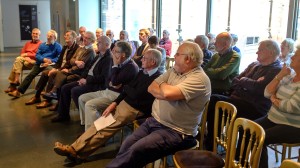
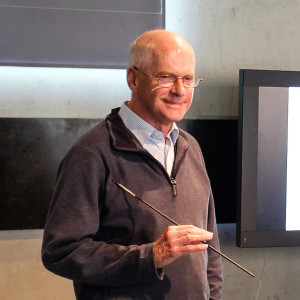
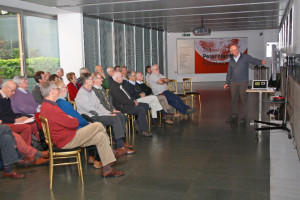
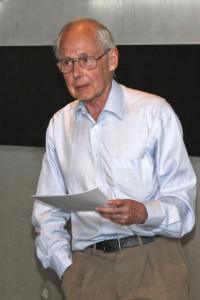
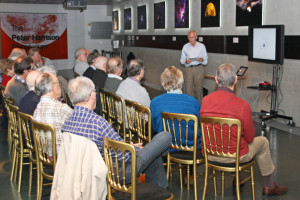










You must be logged in to post a comment.